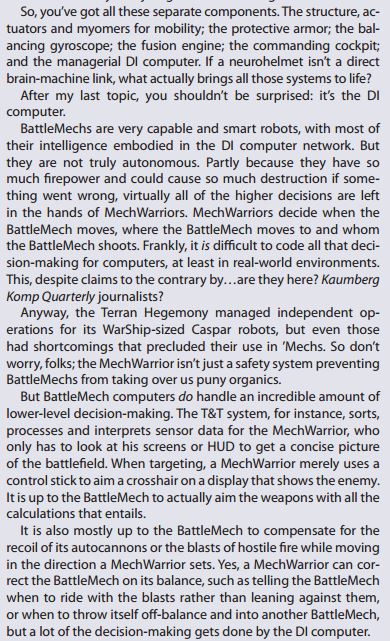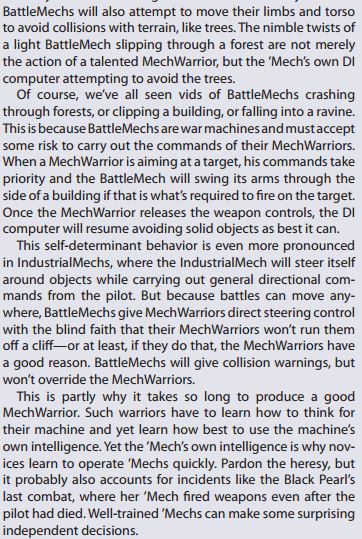 stjobe, on 23 September 2014 - 02:36 PM, said:
stjobe, on 23 September 2014 - 02:36 PM, said:
And quibbling, don't forget quibbling.
When the Tech Manual clearly states "BattleMechs are very capable and smart robots" (emphasis mine, see image of page 42 above for source), it's kind of disheartening to see people going "nuh-uh, it's no robot, it's no different from a tank, or a fighter jet, it's no robot, it's not intelligent, it can't think on its own, it's no robot, it's just a vehicle".
No, they're not fully autonomous, but they're a damn sight smarter than any "simple vehicle", and I've given plenty of lore excerpts to back up my arguments towards that point. The ones claiming 'mechs are just "a tank on legs", that they "cannot move on their own" have given very little to back that up apart from their own highly overrated opinions.
Actually, I pointed out that the degree to which the DI Computer is "smart" is really no different than a modern
flight management system (many of which also include integrated
autopilot and
autoland systems) is "smart".
Yet, aircraft so-equipped are not considered robots, even though they have comparable - and, often,
greater - autonomous operation capability in relation to a BattleMech (as such aircraft could keep flying and even land safely (if approaching an airport with the correct runway systems in place) if the pilot(s) is incapacitated or killed, while a BattleMech would be wholly incapable of moving while remaining upright - much less fighting - if the MechWarrior is likewise incapacitated or killed).
Furthermore, I posted the legal & industry-standard definition of robot, which explicitly states, "The crucial element in robotics is the artificial intelligence carried in the programmable circuitry of the machines", in addition to the presence of one or more "end effectors" and the presence of one or more sensor assemblies.
However, a machine needs to have all three of these to be considered a true robot:
Purely-mechanical automata (such as
those created by al-Jazari in the 1200s, or the original
player pianos of the late 1800s) are not robots under this definition, as they either lack both sensors & AI (as with the player piano), or they have a simple sensor (such as the floats on al-Jazari's "peacock fountain") but no guiding intelligence (that is, no AI).
Smart computers & "
strong/full AI" - such as Cortana & her ilk from the
Halo franchise - are not robots under this definition, since they lack a means to interact with the environment (e.g. they lack end-effectors).
And then, I pointed out how the common vernacular then proceeds to use the term "robot" to incorrectly label a host of things that are anything but that (the specific example I used was the Foster-Miller TALON, though this would apply to popular drones like Predator & Global Hawk as well), while usually eschewing its use in situations where it would actually be appropriate (the specific example that I used was the entrants into the 2007 Darpa Grand Challenge).
Just as many popular depictions of extraterrestrials are humanoid (e.g. superficially similar to true humans (to one degree or another), but without being true humans), BattleMechs are merely robotic (e.g. superficially similar to true robots, but without being true robots) & are referred to as "robots" only as a colloquialism (that is, basically because there is no more-accurate single word currently in widespread usage).





































